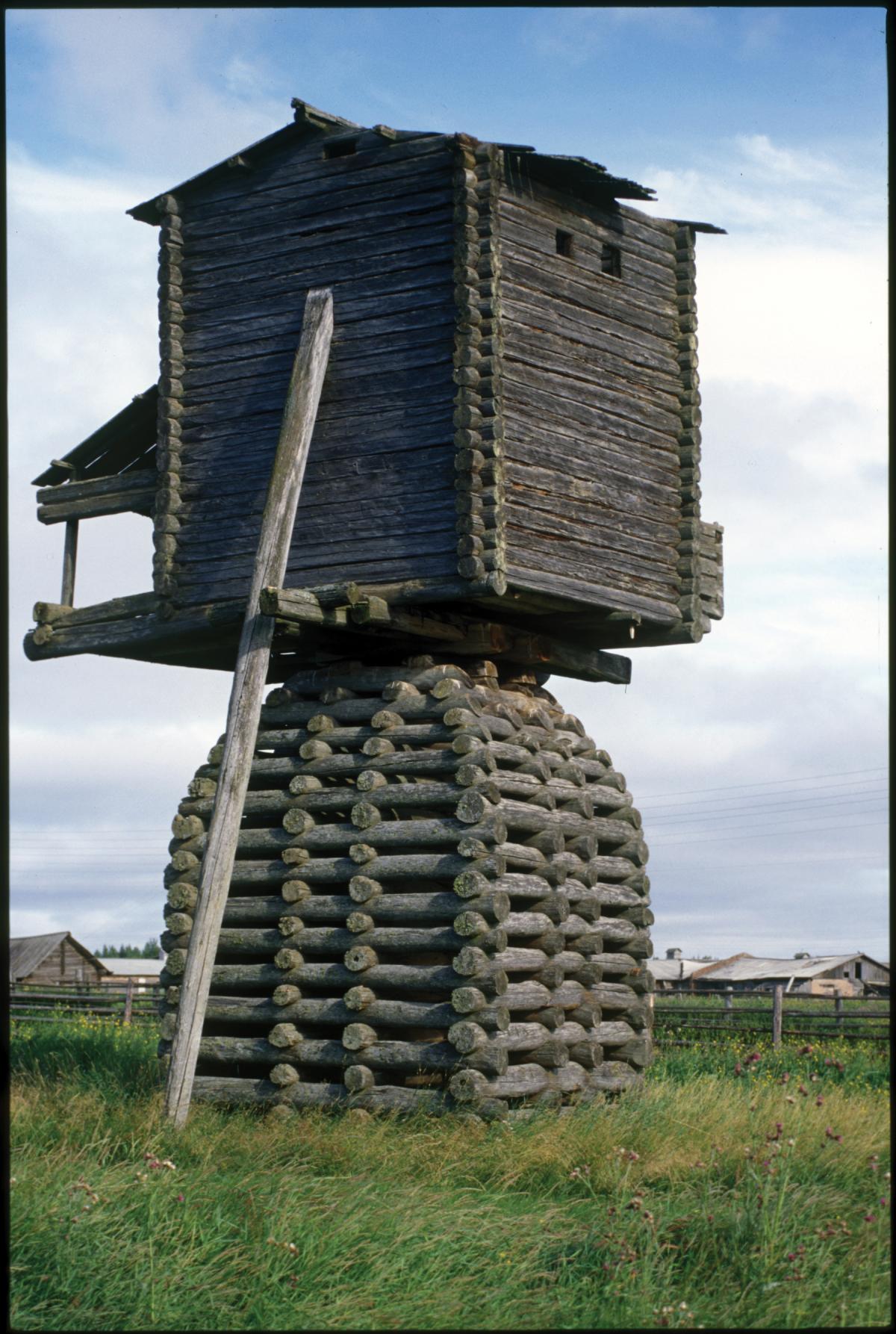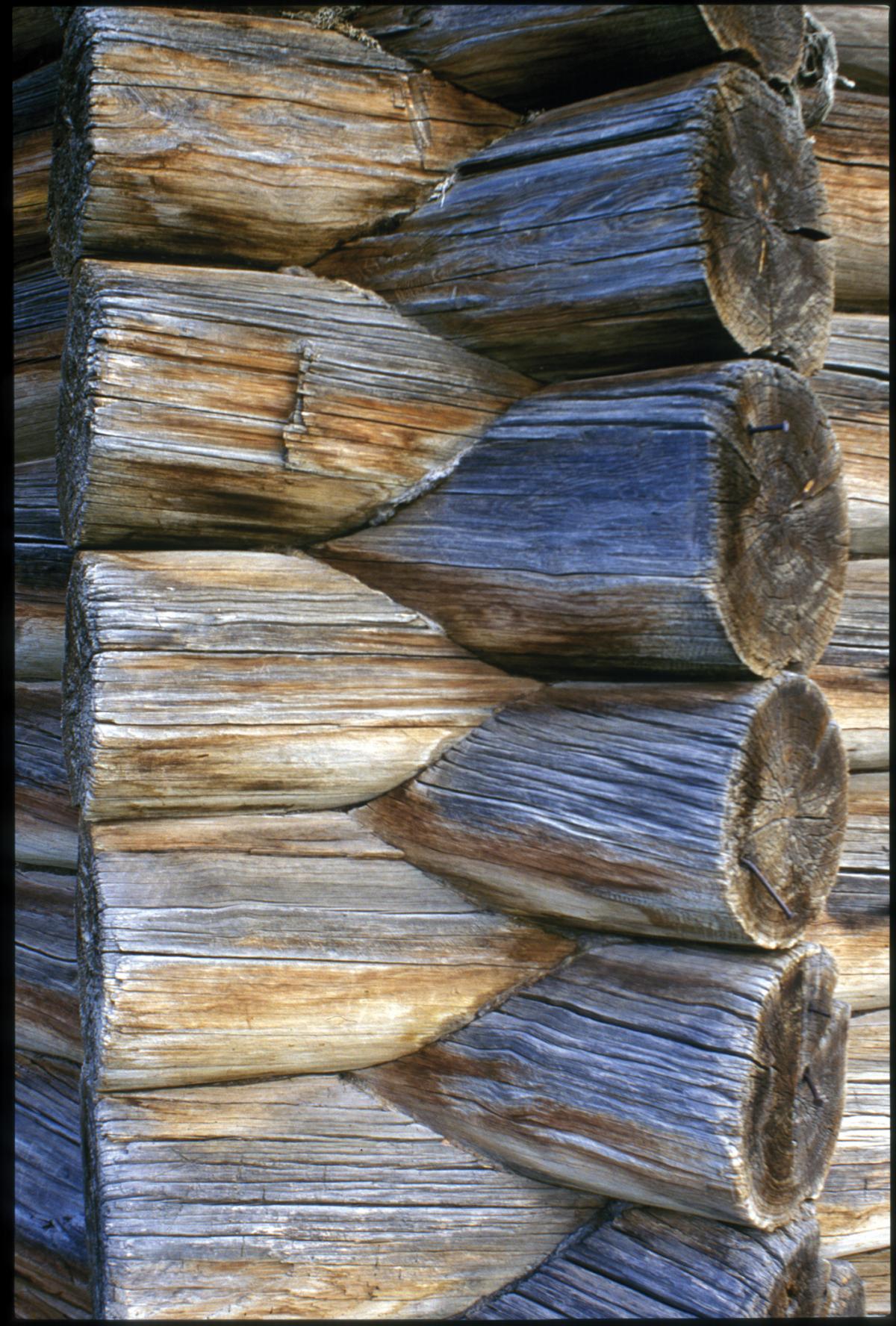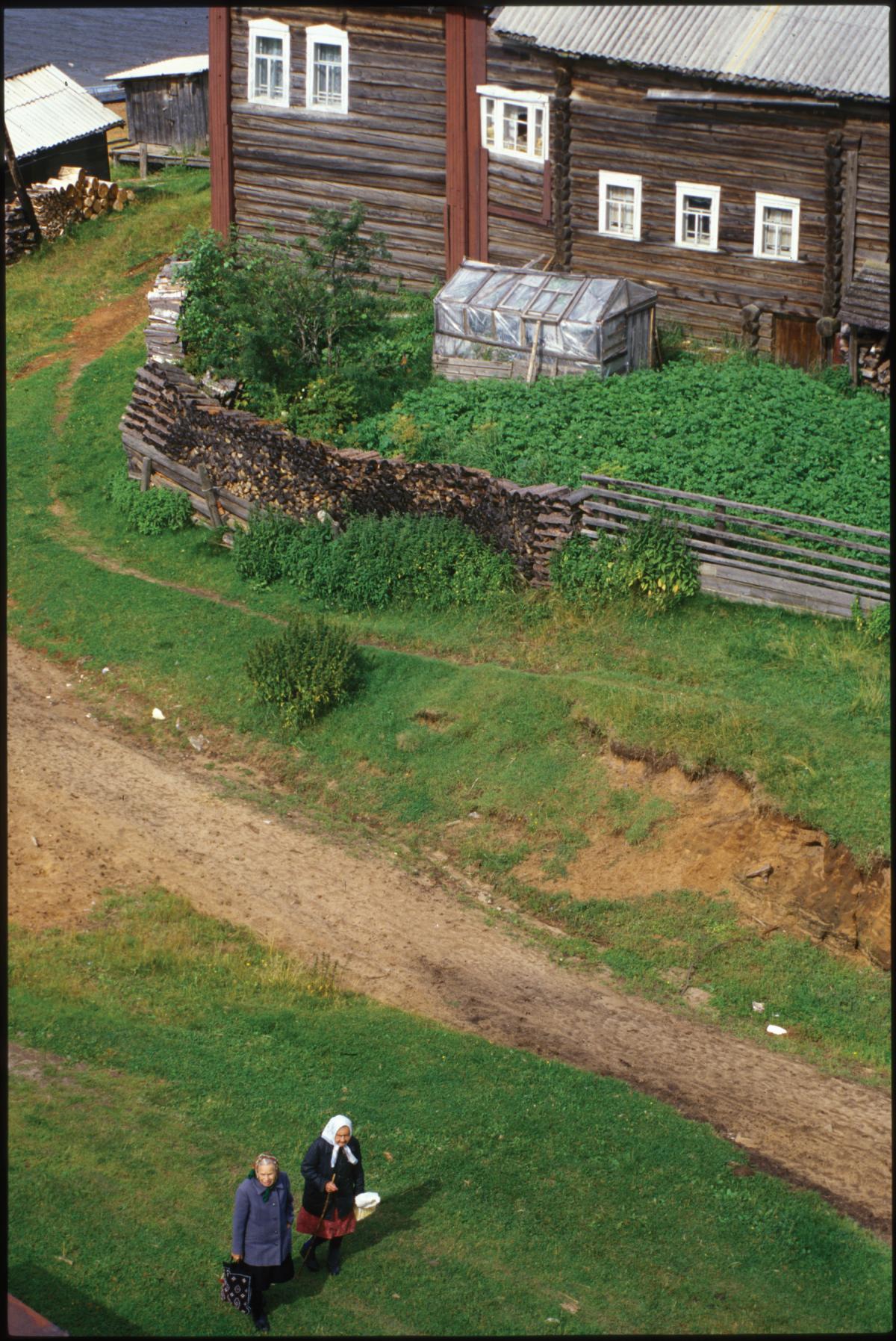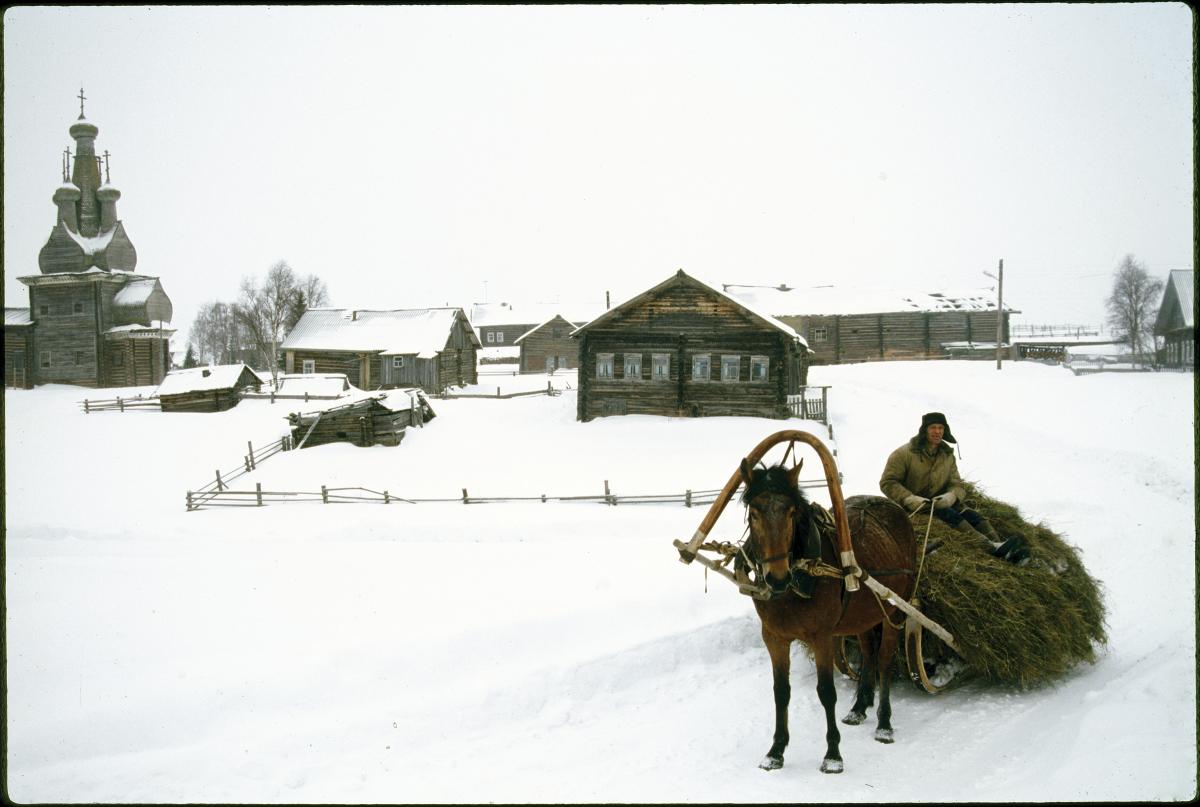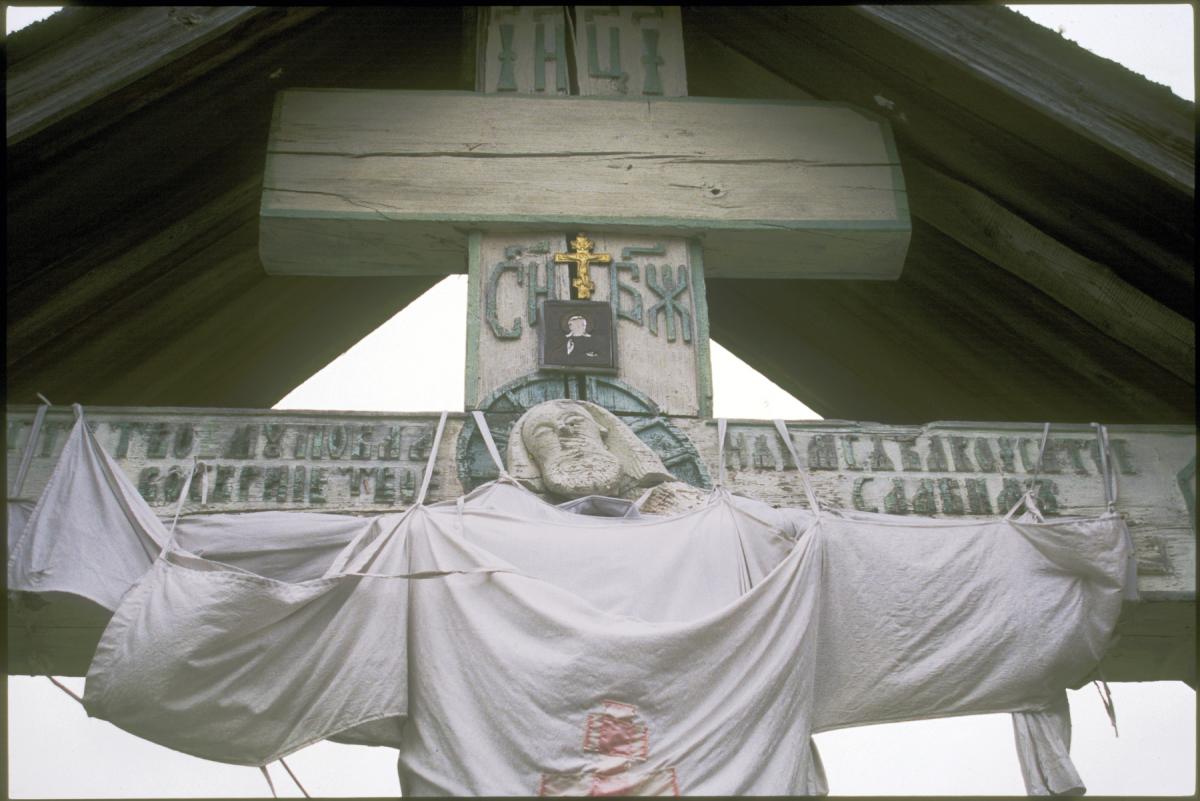On the upper reaches of the Mezen River, in northeast Arkhangelsk province of Russia, one encounters pockets of population that seem to exist in another time. Among them is Kimzha, one of the most distinctive villages I have seen in many years of travel throughout Russia. Most maps do not show this rural hamlet, though it stands near the intersection of two rivers, the Mezen and the Kimzha. Its population varies between winter and summer: a couple of hundred in the winter, and a hundred or so more during the summer, when relatives visit.
Because Kimzha lies encrusted under snow and ice for much of the year, it was appropriate that my first experience of the place occurred in early March. The summer prior, in 1999, I had seen a photograph of the Kimzha church, built in the 1760s and dedicated to the Odigitria Icon of Mary. It showed five soaring towers and cupolas over a structure of massive larch logs. It was enough to convince me that I had to reach this place. Underwriting from the Guggenheim Foundation would cover the expenses. Still, friends in Arkhangelsk warned me of the difficulties: Kimzha would be impossible to reach by land in the summer because of the lack of roads.
Formerly, there was limited scheduled transportation by water from Arkhangelsk, but that had ceased with the collapse of state subsidies. Another possibility was to travel by small plane from Arkhangelsk to Mezen. But I wanted to experience the terrain between Arkhangelsk and the Mezen River, and for that I was told of another mode of travel: over a temporary winter road or, zimnik.
Luckily, I knew a guy. Since 1998 I had maintained close contacts with the main university in Arkhangelsk, Pomor State University, the leading university in Pomorye, the White Sea territory. The first vice-rector of the university, Yuri Kudriashov, was a native of Mezen; and while he had long since left the area, he had maintained contact with childhood friends such as Peter Kondratyev, the director of a lumber factory in Kamenka. Kondratyev provided me with a driver from his company motor pool and a Land Rover, one of several that made weekly runs between Arkhangelsk—the power center—and the twin towns of Mezen and Kamenka. For the driver, this was a regular, if demanding, shuttle trip. For me it was something else entirely.
When we left Arkhangelsk in the early afternoon of March 7, the sun was bright and the frost hard. The Land Rover sped over a paved road along the right bank of the Northern Dvina River until we approached the mouth of the Pinega River, some 100 kilometers to the southeast of Arkhangelsk. At that point we turned east and moved along a reasonably smooth gravel road near the right bank of the Pinega until we reached the town of the same name. The gently rolling terrain had presented few challenges to the Rover. A tractor grader kept the surface even, and high snow banks provided insurance for the occasional skid.
Beyond Pinega, the way to Mezen forked sharply to the north from the main road, and we soon approached the deep taiga forest. The grades became much more primitive, and the track narrowed. This was the beginning of the zimnik. Despite the apparent remoteness of the area, the track to Mezen carries a small but steady stream of traffic—including, to my amazement, twice-weekly service in small buses. And where there are drivers, there will be road stops. In the tiny village of Chizgora, we stopped at a log hut with the usual assortment of engine oil, beef jerky, soap, and ramen noodles. A stocky militia captain ate microwave-warmed pelmeni, and in the corner a small television projected a flickering black-and-white image of Jamie Lee Curtis in A Fish Called Wanda. It would have been funny to watch the scene where John Cleese seduces Curtis with a recitation of some of the most elegant nineteenth-century Russian poetry, but we had a ways to go.
As we drove, the forest suddenly thinned, and the road improved into a straight causeway through what appeared to be a marsh. Although the hour was close to eleven, floodlights loomed in the distance. Excavators tore at rock-hard earth, and the roar of heavy dump trucks shattered what had been the unbroken silence of the forest. The driver explained that “they” had decided to build an all-year road through forest and marsh directly to Mezen, via Kimzha. In the meantime we plunged back into the forest, with nothing in front of the headlights but a snow track and endless rows of fir and pine trunks. Around midnight, the driver, nodding and exhausted, mumbled that we were finally there.
To arrive at Kimzha in the middle of a winter night produces an eerie impression, all the more because the first thing one sees is not the village—which is located to the side of the road—but a group of large crosses, stark and ghostly in the sharp contrast of the headlights’ glare. This was a startling apparition, and one of great beauty.
But, I wanted to know, where was the village and my promised shelter? Despite the late hour a workshop on the edge of Kimzha was brightly lit, part of a service area for the road builders. The directions we received there took us into the village, where we again lost ourselves in a maze of log walls. After stumbling through snowdrifts, I found the small log house where I was to spend the night. Before going inside, I looked upward and saw the aquamarine shimmer of the aurora borealis. This was the last clear sky I would see in the Mezen region on this trip. The next hour brought a new weather front of constant snow and wind for the next three days. But in that brief moment I could clearly see the looming specter of the Kimzha church.
As for my accommodations, I had been told that the house was new. So new, it turned out, the building was unfinished. But it was warm and dry, and I had no trouble with the spartan room, with its window that looked out upon the village. The next morning my host, Georgy Fedorkov, and his brother (both retired on pensions from the lumber plant) provided a hearty breakfast of kasha, fresh milk, and simmering beef stew. The wind and snow continued unabated, and my attempts to call Mezen from a neighbor’s house failed; the telephones were out. Kondratyev had planned to bring me from Kimzha to Mezen, but I was stranded in the middle of a snowstorm.
Despite the stiff wind and treacherous snow drifts, I decided to photograph as much as I could, partly as a way to relieve the tension. The church, of course, was my primary objective. This was the sole surviving example of its type, apparently created by a group of carpenters active only in this part of the north. The brilliance of their design, perfectly proportioned, is still a source of amazement to me.
But for all of the monumental power of the church, what surprised me still more was the extent to which the village’s massive log houses, built during the late nineteenth and early twentieth centuries, had been preserved. This was not an open-air museum, with a few reconstructed log buildings. Some of the houses had been abandoned or at least shuttered for the winter, while a few others had been modified with plank siding. But Kimzha remained a functioning, living environment.
How to explain this degree of preservation—of the buildings and of the community? Perhaps the very absence of roads, the “isolation factor,” protected the integrity of the environment. Yet that alone was not sufficient to explain the survival of Kimzha, when hundreds of other villages throughout the north had vanished. It occurred to me that the existence of the church, although closed until 1999, might have contributed to the village’s endurance. I decided to revisit Kimzha under more favorable conditions, during the summer, in order to explore further the sources of its strength.
The morning’s photography produced two rolls of film before driving snow threatened the workings of camera and lenses. By eleven my primary concern centered on finding transportation to Mezen before the roads became completely snowed in. Fedorkov suggested that I turn to the road builders, whose shop I had seen the night before. Now I got a closer look. Even under clement conditions, it is extremely difficult to build a road straight through a northern swamp. I was told that the crews work throughout the year, day and night, on a week’s rotation. At this rate the road should be completed within another two years. In view of the budget difficulties in the Arkhangelsk region, it is unlikely that the project would have gotten this far without some form of subsidy or promise of a payback in natural resources.
I looked into the equipment garage, saw a bulldozer under repair, and wondered what could ever bring this inert lump of metal back to motion. The blade was encrusted with a type of local clay that hardens to the consistency of rock, especially in the winter. While we discussed the possibility of my hitching a ride to Mezen with one of the road crews, I managed to see the bunkhouse and work room, thick with cigarette smoke, as well as the canteen, where a fresh load of bread baked in a nearby village had just arrived. The hash hound, who appeared to be just out of the army, cooked up several dishes of crude but edible, calorie-laden fare. I could only eat my way through two.
At noon we heard of a group of surveyors who were heading to Mezen in their Uazik (the Russian equivalent of the traditional jeep) and were willing to take me along. As they packed their gear, a small car drove up with three passengers—Russian Baptist missionaries from St. Petersburg who had come to the Mezen region to spread the Good News and distribute copies of the New Testament. A bit later I noticed one of the crew idly thumbing through a copy in the bunkhouse, where only a little before a card game was in full swing with the usual incessant profanity. As for the villagers, one noted laconically: “They won’t get very far here.” While I pondered that judgment, a woman in a quilted jacket opened the long village stable, and out came several horses, some of whom rolled in the snow, while others ambled through the drifts. I remember very clearly the rime of snow on their dark coats.
In Alexander Solzhenitsyn’s novel First Circle, the ruins of a church tower cause a member of the Soviet elite to ponder his previously unexamined fate. Certain cultures seem drawn to their ruins, their relics, their ghosts, and their shadows. Russia is one such culture. The American South is another.
During my work in the north, Russian colleagues often commented on similarities between their attitudes and what they interpreted as my Southern spirit of respect for tradition and cultural legacy. Indeed, it has been easier for certain Russians to accept me as the representative of a region (even one they know primarily through the translation of Gone with the Wind) than as a citizen of the United States.
But the affinity between Russia and the American South first struck me during a stay in Leningrad in 1971. The beauty of the city, even in its decrepitude, haunted me—and reminded me of New Orleans, founded fifteen years after St. Petersburg. The original designs of both owe much to French military engineering. That year I also gained a deeper appreciation of the appeal of Southern literature in Russia. Translations of Faulkner’s novels and productions of Tennessee Williams’s plays were the most obvious examples, and my still imperfect Russian was stretched to the limit in describing mysterious New Orleans to Russian listeners.
Russia also has in common with the South the feeling that, as Faulkner himself put it, “the past is not dead. In fact, it’s not even past.”
In the Russian north, the primary region of my photographic field work for over a decade, I visited dozens of villages whose surviving architecture bears witness to a remarkably creative and resilient culture over the past century. Unfortunately, many villages have disappeared or been depopulated as the result of demographic shifts and the aftermath of economic and social policies (including ruthless collectivization) of the Soviet regime.
In both places, old wounds still hurt. The legacy of slavery and the effects of a devastating war waged primarily on the territory of the South continue to dominate the Southern imagination. Russia too once depended on the labor of a subordinate class, and its aristocratic history (along with its intensely hierarchical Soviet history) attests to great historic inequalities in fact and in law.
Russia and the South also both have ghosts in a more traditional sense: those who have fallen in battle on blood-stained ground. In the course of travels throughout Russia, I have noted—and in many cases photographed—war memorials that exist in almost all Russian settlements, even small villages such as Kimzha. One can endlessly debate the reasons and responsibilities for this huge loss of life, but the scale of the sacrifice is beyond debate. Growing up in the American South, I gained an early interest in military history that has continued to play a role in my understanding of Russian history and the Russian mentality. I have taken this interest—in a very personal, perhaps irrational sense—as a lesson in defiance: to take from every setback a determination to recoup. By going North I return to the South.
In late July, again in Arkhangelsk, I purchased a plane ticket and left from the small regional Vaskovo airport. The view from the air was spectacular during the hour-long trip. The taiga forests, bogs, and meandering rivers took on an otherworldly look. I could scarcely imagine the terrain that I had covered with such difficulty a few months earlier.
Upon arrival in Mezen, I was escorted by the major who headed the local militia, and, after due formalities, was driven in a brand-new Uazik to the village of Dorogorskoe, across the Mezen River from Kimzha. There I met the head of the local village council, Aleksei Zhitov, who made it clear that he pretty much controlled what happened in Kimzha. Not an easy job, as it happens, and the silting of the Mezen River has made it much harder. As I later saw, simply getting a small barge of fuel oil over to the other side was a very difficult, even dangerous, operation—and without oil the village of Kimzha has no electricity. It came as no surprise to learn that Zhitov was suffering from a serious ulcer.
A local fisherman got me up and over the river to Kimzha in an aluminum boat with a sputtering outboard. Now I was here, but where was the sun? After leaving my gear in Fedorkov’s house, I moved through the village with two cameras. What a relief to walk without the constant impediment of snow drifts, however picturesque. Now the land was swathed in green, and I staunched my disappointment over the sun. A stiff wind was pushing the cloud layers around. A group of children followed me, the visitor from another planet, with a patter of questions. Then the sun appeared. As I ran toward the center, with the village kids cheering in my wake, the church acquired that rich glow that only late northern light can impart.
The next days brought the same alternation of cloud and sun, and I had time to contemplate the ever—changing image of the church. I also met some of the people from the local parish. This dedicated group—predominantly women—had succeeded in 1999 in having the padlock removed from the church, which was then reconsecrated by an Orthodox priest.
Although there was no resident priest and no regular service, the church was opened by the women of the church committee at ten in the morning. They had also created a small prayer table (the altar has not been recreated) with an icon of the savior. The door over the vestibule has a reproduction of one of the “tenderness” icons, with Mary and the Christ child. The church ladies were very concerned about the state of the building and worried that Zhitov was unwilling to make basic repairs, particularly to the windows. Their appeals to various foundations went unheeded, although the church is a registered national landmark. A rather slipshod attempt at restoration in the 1980s has long been abandoned, and this too has disfigured the appearance.
As I asked about the parish, I also learned more about the community. Although the former dairy kolkhoz, surrounded by rusting machinery for which there is no fuel, is a shadow of its Soviet size, a large part of the dairy herd has reappeared through individual ownership. I had ample opportunity to partake of the fresh milk, cottage cheese, and ryazhenka (a thick sour milk similar to buttermilk) produced throughout the week by individuals who own cows. The villagers are also sustained by the forest and by the rhythm of its seasons—a time for berries, a time for mushrooms, a time for hunting and fishing. Late one afternoon, Elena Repitskaya and Antonina Mamontova arranged a tasting session at which I sampled over a dozen types of jams and other concoctions from the various types of local berries. No Moscow restaurant could have offered better. It also came as a surprise to find that Kimzha has retained a number of residents in their thirties with young children. These families tend to be large and of modest means. Much of their income will eventually go to educating their children in a large town. But in the meantime these families—and others who come for the summer—are quietly proud of being a part of the village.
Like all complex environments, Kimzha does not submit to easy definition. I came to realize that it was not some isolated pocket of the past. The villagers no longer sit around singing authentic folk songs. Many are retirees from the lumber plant, and their children have moved to larger places. When they return for the summer, more urban elements appear in the culture of the village. Television, for instance, is widespread. Life here shares much with life anywhere in the country. And yet, these surviving ancient villages are stunning microcosms of Russian traditions, many of them now forgotten.




